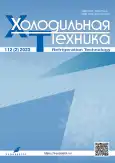Application prospects of a central air conditioning system in an engine room at a waste water pumping station
- Authors: Razakov M.A.1
-
Affiliations:
- Moscow Power Engineering Institute
- Issue: Vol 112, No 2 (2023)
- Pages: 87-97
- Section: Original Study Articles
- URL: https://journal-vniispk.ru/0023-124X/article/view/259193
- DOI: https://doi.org/10.17816/RF622931
- ID: 259193
Cite item
Abstract
BACKGROUND: Engineering support is crucial for controlling microclimate parameters in rooms experiencing high thermal excesses. It is necessary for mitigating the impact of technological processes on worker health. Recent instrumental research has classified the engine room of a high-voltage sewage pumping station as one such environment, owing to its specific technological conditions that result in significant heat generation. This has led to exploring the potential use of air conditioning systems for such type of rooms in buildings.
AIMS: The objectives are to assess the feasibility of implementing a central air conditioning system in the engine room of a city's high-voltage seweage pumping station and to calculate the capital costs for installing refrigeration elements.
MATERIALS AND METHODS: The study involved reviewing current scientific literature on the viability of air conditioning systems for such applications and conducting preliminary calculations of the required characteristics for refrigeration equipment. It was found that modern design solutions for refrigeration equipment can be integrated into the engine room.
RESULTS: The study found that installing an air conditioning system using an artificial cold source (refrigeration machines) for a structure operating with 5 pumps amounted to 49,450,000 rubles. For designs with 3 working units, the cost of the equipment was estimated at 25,650,000 rubles. Employing only air humidification strategies would reduce capital costs to 9,900,000 rubles (for 5 working pumps) and 5,800,000 rubles (with 3 working pumps).
CONCLUSIONS: Although implementing an air conditioning system in high-voltage sewage pumping stations is feasible, it requires large investments during the installation and operation processes. Operating costs during warmer months would be higher if only air humidifying equipment is used instead of installing refrigeration machines.
Full Text
##article.viewOnOriginalSite##About the authors
Muhammet A. Razakov
Moscow Power Engineering Institute
Author for correspondence.
Email: RazakovMA@mpei.ru
ORCID iD: 0000-0002-0419-4522
SPIN-code: 8054-6877
researcher, Lecturer
Russian Federation, MoscowReferences
- Nikolaeva LA, Khusnutdinov AN. A Study of the Absorption of Nitrogen Oxides from the Boiler Flue Gases. Thermal Engineering. 2018;65(8):575–579. (In Russ.) doi: 10.1134/S0040601518080049
- Korol E, Shushunova N. Analysis and Valuation of the Energy-Efficient Residential Building with Innovative Modular Green Wall Systems. Sustainability. 2022;14(11):6891. doi: 10.3390/su14116891
- Samarin O. Thermal mode of a room with integrated regulation of microclimate systems. Magazine of Civil Engineering. 2022;8(116):11610. doi: 10.34910/MCE.116.10
- Abdullin VV, Shnayder DA, Kurzanov SYu, Yavorovsky YuV. IOT technology applications to building heating: predictive control, distributed monitoring, smart hydraulic balancing. Plumbing, Heating, Air conditioning. 2018;8(200):54–58. (In Russ.)
- Banhidi L. Thermal comfort of rooms. Moscow: Stroyizdat; 1981. (In Russ.)
- Pozin GM, Ulyasheva VM. Distribution of air parameters in premises with heat release sources. Magazine of Civil Engineering. 2012;6:42–47. (In Russ.) doi: 10.5862/MCE.32.6
- Gasho EG, Prokhorov VI, Moroz AT, Frantsenyuk LI. Cooling conditions of hot rolled steel coils. Steel in the USSR. 1987;17(2):86–87. (In Russ.)
- Razakov MA. Engine room thermal density specials in heating systems shutdow process. Power engineering: research, equipment, technology. 2022;24(6):133–142. (In Russ.) doi: 10.30724/1998-9903-2022-24-6-133-142
- Starkova LG, Datsuk TA, Ulyasheva VM. Numerical simulation of aeration in a hot rolling workshop. Bulletin of civil engineers. 2022;5(94):76–82. (In Russ.) doi: 10.23968/1999-5571-2022-19-5-76-82
- Ulyasheva VM, Anisimov SM, Shamkolovich AN. Numerical simulation of ventilation processes in the welding shop. Bulletin of civil engineers. 2019;3(74):118–124. (In Russ.) doi: 10.23968/1999-5571-2019-16-3-118-124
- Melkumov VN, Kuznetsov SN. Dynamics of Formation of Air Streams and Temperatures Fields in Premise. Scientific Herald of the Voronezh State University of Architecture and Civil Engineering. Construction and Architecture. 2009;1(1):25–34. (In Russ.)
- Grimitlin AM, Strongin AS. Assessment of the efficiency of the use of activating turbulent jets to eliminate the risk of the formation of unventilated zones in large. J. Phys. Conf. Ser. 2021;2131(1):052068. doi: 10.1088/1742-6596/2131/5/052068
- Belova EM. Central air conditioning systems in buildings. Мoscow: Euroclimate; 2006. (In Russ.)
- ASHRAE Handbook - Fundamentals. ASHRAE; 2017.
- Dement’eva МЕ, Kurokhtin АА. Features of operation of sewage pumping stations of heat and power stations in conditions the Far North. Vestnik MGSU. 2019;14(3):356–366. (In Russ.) doi: 10.22227/1997-0935.2019.3.356-366
- Yakovlev BN, Bondarev VV. Research of the air environment in different enterprises and industries sewage pumping stations. Manuscript №186-B2004 VINITI RAS; 2004. (In Russ.)
- Oblienko AV, Potapova SO, Sushko EA. Experimental investigation of explosive and flammable substances distribution in industrial premises. Russian Journal of Building Construction and Architecture. 2010;3(19):154–163. (In Russ.)
Supplementary files














